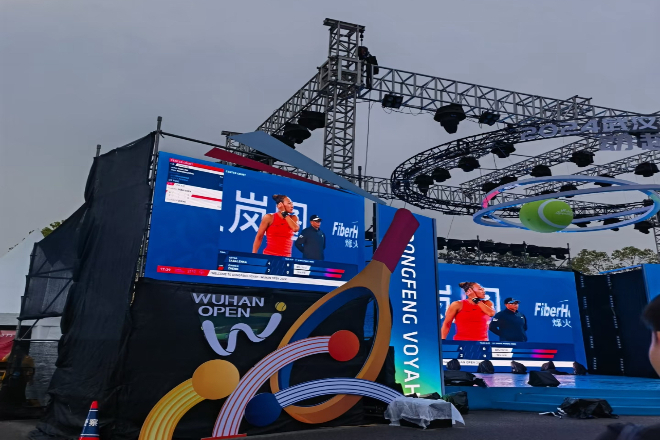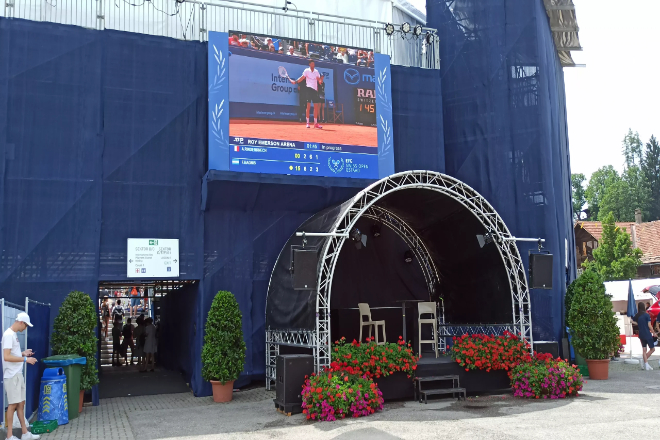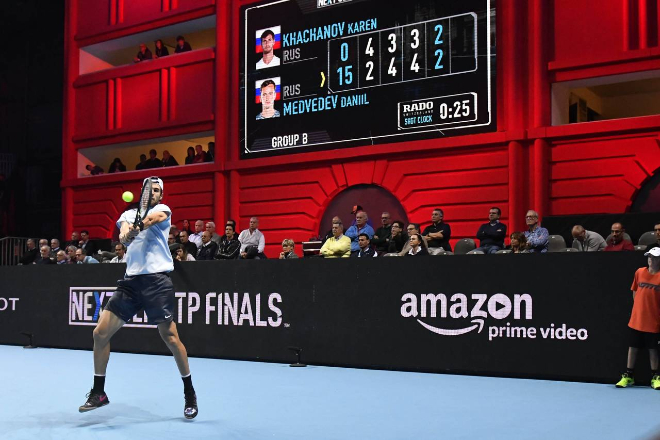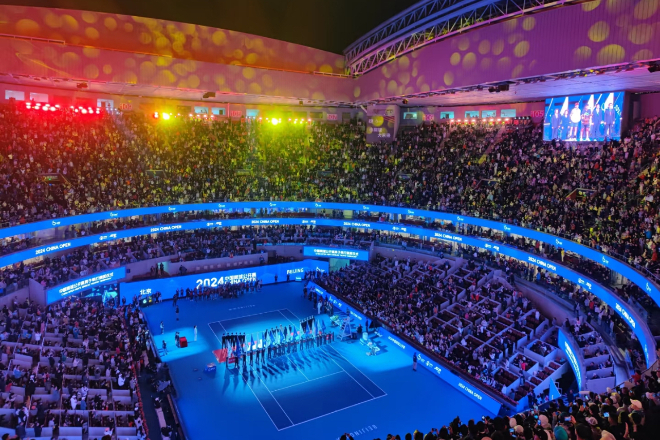Introduction
Do you know? In addition to the wonderful performance of the players, there are actually many “behind-the-scenes heroes” behind a wonderful tennis match.
For example, those Écrans d'affichage LED that glow silently beside the tennis court are not just simple screens but also the key to improving the viewing experience.
In this article, let’s talk about the special requirements for LED display screens at tennis matches. I believe that after understanding these, you will look at them with new eyes!
Table des matières
Requirement 1: Special requirements for LED display screens in the tennis court environment

1). Venue lighting conditions
Tennis matches are mostly played outdoors or in semi-open places, and the sunlight is particularly dazzling.
This requires the LED display screen to be bright enough; otherwise, the audience can’t see the content clearly under strong light.
Generally speaking, the luminosité of the display screen must be at least 5000cd/m² so that the picture will not be “drowned” under the sun.
Moreover, the display screen must have a good contrast; otherwise, the picture will look blurry. Just like in a dark place, if the contrast of the screen is not enough, the picture will appear gray.
Therefore, for outdoor displays, the contrast ratio should be 1000:1 so that the audience can see clearly and the colors are more vivid.
In addition, the screen surface should be glare-resistant; otherwise, the reflected light will make the audience uncomfortable and affect the viewing experience.
2). Venue layout restrictions
The tennis court is limited, so the LED display screen cannot be too large and cannot be installed randomly. It must be installed in the corners of the court.
For example, the side or corner of the court and the height cannot be too high. Otherwise, it will interfere with the players’ play.
For example, if the screen is installed within the player’s line of sight, the player will be distracted when playing and may even hit the screen.
At the same time, the display screen must leave enough space for easy maintenance otherwise it will be difficult to repair if there is a problem.
Moreover, considering that the players are running around on the court, the display screen is better with an anti-collision design so that if the players accidentally hit it, they will not be injured, so the game can be carried out safely.
3). Audience sight and angle
When watching a tennis match, the audience seats are around the court, and the audience comes from all directions. This requires the LED display screen to allow the audience from all angles to see the picture clearly.
Le angle de vue of the display screen must be wide enough, with at least ±50° horizontally, about 10° upward, and about 20° downward.
In this way, the audience can see the screen no matter where they sit. If the venue conditions permit, you can install more screens or distribute the screens in different positions so that no matter where the audience sits, their vision will not be blocked.
Moreover, the height and angle of the screen installation should also be adjusted according to the position of the audience seats so that the picture is just aimed at the audience’s eyes so that everyone can watch comfortably.
Requirement 2: Adaptability of LED display content to tennis games

1). Score and competition system information
The score and competition system of tennis games are among the most important aspects of the audience’s attention, and the LED display screen must clearly display this key information.
In terms of scores, the current score should be displayed in real-time, including the score, number of games, and number of sets for each game.
For example, whether it is the first set or the second set, and the current number of games is a few, all this information should be clear at a glance.
At the same time, the competition system should also be clearly displayed, such as whether it is a three-set two-win system or a five-set three-win system.
In this way, the audience can clearly know the progress and rules of the game and better engage in the game.
2). Player information display
Player information is also very important. The display screen can display the player’s name, nationality and ranking so that the audience can quickly understand the contestants.
In addition, some technical data can be displayed, such as serving speed and first-serve success rate.
The serving speed can be displayed in numbers, such as “200km/h”, and the first serve success rate can be expressed in percentages, such as “75%”.
These data can allow the audience to have a deeper understanding of the player’s performance and increase the viewing value of the game.
3). Event information and prompts
In addition to the score and player information, the display screen should also provide some event-related prompt information.
For example, the start time of the game, the pause time, and the rest time between games.
This information can help the audience better plan their viewing time and also let the athletes know the progress of the game.
For example, during the rest between games, the screen can display “rest between games, remaining time XX minutes” so that the audience and athletes can clearly know the rhythm of the game.
Requirement 3: LED display technology and tennis matches

Tennis matches are fast-paced and intense, and the audience has high requirements for the smoothness and clarity of the picture.
The technical performance of the LED display must meet the following points to better adapt to the scene of the tennis match.
1). Haut fréquence de rafraîchissement
In tennis matches, the players’ movements are very fast, such as serving and hitting. If the refresh rate of the display is not high enough, the picture will appear smeared, and the audience will look blurry.
For example, in some large-scale events, such as the Shanghai Rolex Masters, the refresh rate of the LED display in the venue is very high, at least 384Hz.
In this way, the picture can be smooth, every move of the player can be clearly displayed, and the audience can better appreciate the wonderful moments of the game.
2). Low latency display
The real-time nature of the game information is also very important. For example, if the display delay is too long, such as score updates and player data changes, the audience will feel that they can’t keep up with the rhythm.
In some international events, the delay of the LED display is usually controlled within 10 milliseconds. In this way, the scores and data seen by the audience are the latest, and they will not miss key information due to delays.
3). HD résolution
To allow the audience to see the details of the game, such as the players’ expressions and the trajectory of the ball, the resolution of the display must be high enough.
At least 1080p resolution must be supported so that the picture will be clear and delicate.
For example, in the US Open, the LED display screen in the venue uses HD resolution to ensure that the audience can clearly see every detail of the game, even if they are sitting far away.
Such a high-definition display can not only enhance the audience’s viewing experience but also better show the wonderful moments of the game.
Requirement 4: Installation and layout of LED display screens

1). Installation location
When installing LED display screens in tennis courts, location selection is critical. Generally speaking, it is best to install the screen on both sides or behind the tennis court.
Why? Because it will not block the players’ sight, the players will not be disturbed by the screen when playing, and the audience can also clearly see the content on the screen from all angles.
For example, in a big game like the Wimbledon Tennis Open, the LED display screens on both sides of the venue are clearly arranged, and the audience can easily see the score and other information no matter where they sit.
If the screen is installed in front of or in the middle of the court, the players will be easily dazzled by the screen when playing, or the audience will be blocked by the screen when watching the game, and the experience will be much worse.
2). Installation height
The height of the screen installation is also very particular. Generally speaking, according to the height of the tennis court audience seats, the height of the screen should be between 2.5 meters and 3.5 meters.
This height is just right; the audience can see the screen when they look up, and they will not feel that the screen is too high or too low, affecting the viewing effect.
For example, in some small community tennis courts, the audience seats are relatively close to the court.
The screen is installed at this height, and the audience can easily see the content on the screen without looking up or down.
If the screen is installed too low, the audience in front of the person will block it and can’t see anything; if it is installed too high, the audience has to keep their heads up, and their necks will be sore after a long time.
3). Multi-screen linkage
In large tennis events, such as the US Open, multiple small screens are often set up to meet the viewing needs of audiences in different positions. These small screens are linked to the main screen to display pictures from different angles.
Why do this? Although the main screen can display the main picture of the game, sometimes the audience may also want to see a close-up of the players or a slow-motion replay.
At this time, the small screen can come in handy. For example, the main screen displays the main picture of the game, and the small screen can display a close-up of the players, score details or slow-motion replay.
In this way, the audience can enjoy the game from multiple angles, and the viewing experience is naturally improved.
Moreover, this multi-screen linkage method can also allow the audience to see the details of the game more clearly, such as the players’ expressions, the trajectory of the ball, and even the referee’s penalty gestures, which can be seen clearly.
5. Conclusion
After reading these requirements, do you think that the LED display screens at the tennis match are actually quite powerful?
They must not only be bright and clear but also consider the audience’s sight and the safety of the players, and they must be able to update the score and data in real time.
The next time you watch a tennis match, you might as well pay more attention to these screens, and you will find that they add a lot of excitement to the game!
Enfin, si vous souhaitez en savoir plus sur les écrans d'affichage LED, veuillez nous contacter.
